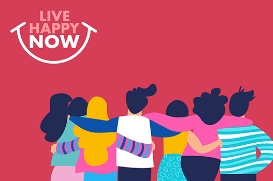Meaning and service are essential elements of the well-lived life.
After a challenging week at work, Saturday afternoon beckons—a stretch of free time to do with whatever you like. You want, reasonably enough, to spend those precious hours in a way that will bring you the most happiness. So you decide to:
a. Whip up a batch of piña coladas, park yourself on the couch and catch up on six episodes of The Real Housewives of New Jersey while munching on two or three (or four) red velvet cupcakes.
b. Go door to door beseeching your neighbors to sign a petition demanding a traffic light be installed on the corner of Fourth and Fig, followed by two hours spent picking up litter and dog droppings from the local park.
Which scenario do you choose?
OK, both choices are fairly preposterous. But they offer a clear-cut illustration of what experts see as two paths to happiness.
Choice A is an example of hedonia. This is in-the-moment pleasure with no limits or rules. It’s self-gratifying, self-serving; the consumption of things and experiences that produce positive feelings and no pain. Hedonia is the fast-food version of happiness, or, as Michael Steger, Ph.D., director of the Laboratory for the Study of Meaning and Quality of Life at Colorado State University, puts it, “Hedonia is doing whatever the hell you want.”
Choice B is entirely more sober, a type of satisfaction that experts call eudaimonia. (You can already tell that this is a far more effortful path; the word itself is nearly impossible to spell correctly or to pronounce. u-dy-MOH-ni-a—if you’d like to try.) Eudaimonia is centered on fulfilling our potential; it’s driven by virtue and a higher purpose: service to others. This is a condition we achieve, says Alan S. Waterman, Ph.D., a leading happiness researcher and professor emeritus in psychology at The College of New Jersey, when we live in accordance with our truest self.
The concepts of both hedonia and eudaimonia date back to the Greeks. Trust us, you would not have wanted to give Aristotle the job of picking up a keg for the Sigma Phi frat party. As he saw it, those who conceived of happiness as pleasure and gratification were “the most vulgar,” or barely human. “The life they decide on,” he scolded, “is a life for grazing animals.” Eudaimonia, on the other hand was “an activity of the soul in accordance with virtue.”
In the last few years, scientists in the field of positive psychology have taken up an examination of these two components of happiness. Their investigations are providing some valuable insights into how each impacts our psychological and physical health. Spoiler alert: The research doesn’t provide any clear-cut answers to what will lead to my or your happiest life. “Within each person lies the ultimate compass,” Michael says. But some of the provocative questions this new research is raising can help you find your true north.
Stepping Off the Hedonic Treadmill
Are you happy now? Right now? How about now? If you were participating in a modern-day happiness study, you might be asked to complete an online daily log. You might have to check off which activities in a list of several dozen you’d engaged in during the previous 12 hours and to then rate your feelings of satisfaction. Or, you might be texted randomly throughout the day, asked what you’re doing and how you feel. When social scientists add up all these caught-in-amber scores and analyze them this way and that, they end up with ratings of both right-now happiness and big-picture, or global, wellbeing.
What these studies generally show is that hedonic behaviors have a short shelf life. Catch someone in the middle of, say, watching an Adam Sandler comedy or scarfing down a Snickers bar, and they’re likely to be pretty content. But a few hours, or even minutes, after the credits roll or the candy wrapper has been tossed aside, those feelings of pleasure recede.
The buzz of eudaimonic behavior, however, lingers. In a study that Michael conducted, the hedonic behaviors he included on a questionnaire were things like “bought a new piece of jewelry or electronics equipment just for myself” and “relaxed by watching television or playing video games.” Among the eudaimonic activities were “volunteered my time,” “listened carefully to another’s point of view” and “persevered at a valued goal even in the face of obstacles.”
People who engaged in more eudaimonic activities not only reported feeling greater satisfaction, stronger positive emotions and more meaning in life, but those feelings spilled over into the next day. They had what could be called a happiness hangover. What’s more, other studies have shown that eudaimonic behavior confers health benefits, too, including a lower incidence of Alzheimer’s and a decreased risk of heart disease.
Considering the health halo that happiness affords, it’s a shame we’re so bad at predicting what’s actually likely to make us happy. You don’t need studies to prove this is the case (though plenty do). Your own experience and that of your friends—especially the perpetually grumpy ones—provide plenty of evidence. The bigger house, the faster car, the latest gizmo-loaded smartphone—all may provide a temporary mood boost, but before long we grow accustomed to these pleasures. In a phenomenon that experts call “hedonic adaptation,” our level of happiness reverts to what it was before we had these fancy baubles. We’re trapped on the “the hedonic treadmill,” holding steady at our happiness set point.
 For a long time researchers believed that our happiness set point was immutable, as much a matter of genetics as the color of our eyes. But lately experts are taking a fresh look at this theory and concluding that our happiness baseline may not be so static after all. A group of researchers at MIT, Harvard Business School and Duke University confirmed that major life events—like winning the lottery—don’t do much to move our happiness needle in any enduring way. But—here’s the good news—small changes in behavior can boost your baseline happiness over time.
For a long time researchers believed that our happiness set point was immutable, as much a matter of genetics as the color of our eyes. But lately experts are taking a fresh look at this theory and concluding that our happiness baseline may not be so static after all. A group of researchers at MIT, Harvard Business School and Duke University confirmed that major life events—like winning the lottery—don’t do much to move our happiness needle in any enduring way. But—here’s the good news—small changes in behavior can boost your baseline happiness over time.
The researchers looked at two behaviors—attending religious services of any type and getting physical exercise. Each time people went to, say, a yoga class or the gym, their church or their synagogue, they experienced a little uptick in happiness. Repeated regularly, these shots of happiness had a cumulative effect that led to a permanent change in wellbeing. The participants in the study had, the researchers concluded, stepped off the hedonic treadmill “one small step at a time.”
Happiness expert Sonja Lyubomirsky, Ph.D., is a psychologist at the University of California, Riverside, and the author of the books The Myths of Happiness: What Should Make You Happy, but Doesn't, What Shouldn’t Make You Happy, but Does and The How of Happiness: A Scientific Approach to Getting the Life You Want. Lately, she’s turned her attention to ways to thwart hedonic adaptation. What she’s finding is that effortful, intentional activities can slow down or sidestep happiness habituation. If materialism leads to a happiness dead end, intrinsic goals take us on a scenic route. Building close relationships, investing in the community, mastering new skills, savoring pleasurable experiences are all strategies that can help us, she says, “stretch happiness.”
Savoring is a strategy that Michael Steger employs daily. We can refresh our experiences, he says, by being mindful of opportunities to luxuriate. Now living in Colorado after growing up in “really flat, boring” Minnesota, he says, he spends a few minutes every day gazing at the mountains. “I don’t want to become inured to the beauty of the natural landscape around me,” he says. “If I’m just seeing rocks, I’ll push myself to look harder, to see where the clouds are over the mountains, or how a recent rainfall has changed the backdrop.”
Easy Does It? Not For True Happiness
“A man’s reach should always exceed his grasp or what’s a heaven for?” the poet Robert Browning wrote. He could have been talking about eudaimonia in that couplet.
“Eudaimonia has more to do with striving than achieving,” says Dr. Antonella Delle Fave, a professor at the University of Milan who has studied life satisfaction across the globe. “It’s about developing and growing into the best person we can be.”
 That effort doesn’t always feel good. “Eudaimonia can be an experience where you’re not happy or even satisfied,” Antonella says. “If you’re engaged in a very difficult work task, you may be absorbed in the project and using all your resources to face a challenge that you feel is meaningful. That generates a feeling of wellbeing…eventually. In the moment, there may be more discomfort than pleasure. Providing support to a friend who has suffered a loss, volunteering in a neighborhood blighted by poverty, training for a triathlon—these also provide a context for engagement that is meaningful, but they are far from carefree activities. Diana Nyad at 64 successfully completing the grueling 110-mile, 53-hour swim from Cuba to Florida, reminding herself to “find a way” with each stroke, was an immeasurably fulfilling experience, but hardly a day at the beach.
That effort doesn’t always feel good. “Eudaimonia can be an experience where you’re not happy or even satisfied,” Antonella says. “If you’re engaged in a very difficult work task, you may be absorbed in the project and using all your resources to face a challenge that you feel is meaningful. That generates a feeling of wellbeing…eventually. In the moment, there may be more discomfort than pleasure. Providing support to a friend who has suffered a loss, volunteering in a neighborhood blighted by poverty, training for a triathlon—these also provide a context for engagement that is meaningful, but they are far from carefree activities. Diana Nyad at 64 successfully completing the grueling 110-mile, 53-hour swim from Cuba to Florida, reminding herself to “find a way” with each stroke, was an immeasurably fulfilling experience, but hardly a day at the beach.
So why bother with things that are hard? In Antonella’s studies of people in Australia, Croatia, Germany, Italy, Portugal, Spain and South Africa, one clear consistency was this: Boredom is a health risk. It turns out that staying within the confines of your comfort zone, partaking only in those hedonic experiences that are at your fingertips—a good meal, an escapist movie, a shopping trip to the mall—is strongly linked to depression. “The worst, most disruptive condition that we found in terms of overall wellbeing was apathy,” she says. “People who didn’t perceive challenges in their lives that called upon them to develop skills and resources had the lowest levels of life satisfaction. In the long run, a life of ease does not allow you to develop into a more complex, mature person.”
Michael agrees. “I’m suspicious of things that are too easy,” he says. “When we look back at our lives many of the things that are most fulfilling, like raising children, making the commitment to be monogamous, taking a job that’s really challenging—require lots of labor, sacrifice, effort and deferred satisfaction over a long period of time. Lots of sleepless nights and cleaning up baby puke might make us pretty miserable in the moment, but we’ll later see those years through a rosy filter. That conflict is exactly what’s amazing about being human, which is that we’re building lives and meaning over the long haul.”
Moving Beyond Mere Pleasure
Maybe happiness isn’t the goal after all. Instead, perhaps we want to embrace, as Zorba the Greek put it, “the full catastrophe of life.” That’s the position taken by Edward Deci, Ph.D., and Richard Ryan, Ph.D., two leading researchers on human motivation at the University of Rochester. “I think it’s perfectly fine for people to be pursuing happiness,” Edward says. “On the other hand, I think there are a lot of other things that are pretty important to pursue. I like to pursue sadness. Sadness is an important human emotion. When my beloved dog dies, I want to experience the kinds of feelings that are associated with that. We have a wide range of human emotions, and I’m interested in pursuing them all in appropriate situations expressed in appropriate ways.” What’s more, adds Richard, happiness shouldn’t be mistaken for wellness. “If I’m a well-supplied drug addict,” he says. “I may be doing things that I know are ultimately harmful, but at the moment I’m happy.”
So, how does “life, liberty and the pursuit of flourishing” sound? Okay, maybe we don’t need to rewrite the Declaration of Independence, but Edward and Richard suggest that “flourishing,” a concept that dates back to high-minded Aristotle, will serve us better than happiness as a life goal. Flourishing, or thriving, results from fulfilling three basic psychological needs. First we need to experience relatedness, or meaningful connections to other people. Whether it’s family, a romantic partner or friends, “I need to feel,” says Edward, “that there are people in this world that I care for, that I want to help when they need help and who would also be willing to help me when I need help.” A sense of competence—that you have the skills and resources to deal effectively with the world—is another basic psychological need. The third basic need is autonomy. “You need to feel that you’re doing the things that you want to be doing,” says Richard, “rather than that life is pushing you around.”
 Happiness, as it turns out, is a fortunate byproduct of this “life of excellence.” Studies show, Richard says, that when people pursue extrinsic goals that have to do with material things, image or fame, they’re less happy—even if they’re successful in becoming rich and famous—than people who are primarily interested in intrinsic goals like relationships, personal growth and giving to their communities. Don’t panic: Edward and Richard’s research doesn’t mean we need to aspire to Mother Teresa-like goodness. “We are not all superstars,” says Edward. “But we can all be kind to the elderly widow who lives next door, try to be nice to the people we meet on the street and, if we have the time or means, find a way to contribute to organizations that are doing good in the world.” Michael points it in even more pedestrian terms. “You can say, ‘I’m going to be less of an annoying person,’ ” he says. “I want people to feel better after they’ve interacted with me. That’s not curing cancer or solving the problem of poverty, but it is opening ourselves to embrace the concerns of others in some small way.”
Happiness, as it turns out, is a fortunate byproduct of this “life of excellence.” Studies show, Richard says, that when people pursue extrinsic goals that have to do with material things, image or fame, they’re less happy—even if they’re successful in becoming rich and famous—than people who are primarily interested in intrinsic goals like relationships, personal growth and giving to their communities. Don’t panic: Edward and Richard’s research doesn’t mean we need to aspire to Mother Teresa-like goodness. “We are not all superstars,” says Edward. “But we can all be kind to the elderly widow who lives next door, try to be nice to the people we meet on the street and, if we have the time or means, find a way to contribute to organizations that are doing good in the world.” Michael points it in even more pedestrian terms. “You can say, ‘I’m going to be less of an annoying person,’ ” he says. “I want people to feel better after they’ve interacted with me. That’s not curing cancer or solving the problem of poverty, but it is opening ourselves to embrace the concerns of others in some small way.”
How to Spend That Saturday Afternoon
In the world outside the psych lab, most activities are neither purely hedonic nor entirely eudaimonic but a combination of both. “In many cases things that are fun often dovetail with things that are noble,” says Michael. “To me, hitting more of these blended moments is a key to the well-lived life.” Take sharing a home-cooked meal with friends. “When we exert some effort that takes into account the experience of other people, I think we’re going to be well on our way to a eudaimonic experience,” he says.
So, how should you spend that Saturday afternoon?
For his part, Michael might pass it sitting on the porch of his Colorado home, enjoying a beer or two while reading a detective novel and glancing up now and then to observe how the shifting light is dancing across the Rockies. “Not everything has to be complicated all the time,” he says. “We can have fun. At the same time we don’t want to neglect that we’re capable of so much more. I think being human is more than trying to string together as many blissful hours as possible and call that a life.”
In other words, we can have our red velvet cupcake and eat it, too. Enjoy a few hours of aimless leisure, then why not go out and ring a few doorbells—literally or figuratively—for something you believe in.
Shelley Levitt is a contributing editor to SUCCESS magazine. Her articles on health, beauty and well-being have appeared in Women’s Health, Fitness, WebMD and Weight Watchers magazines.















